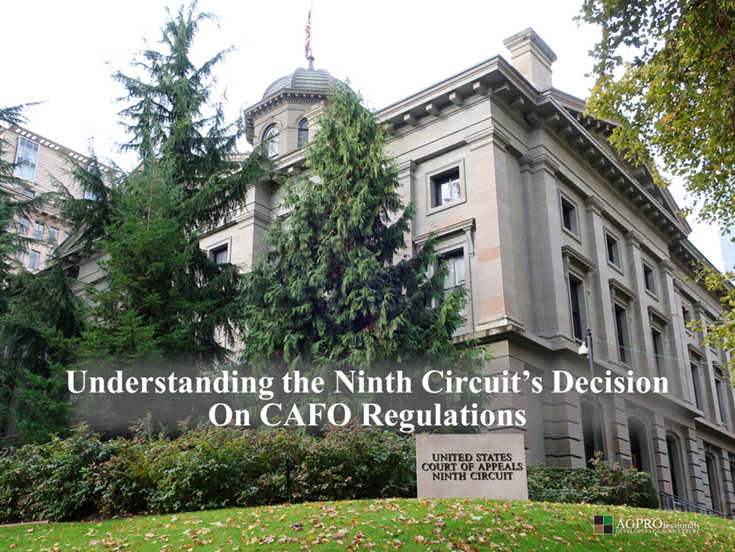
Ninth Circuit Court: A Win For Modern Agriculture on CAFO Regulations
The Ninth Circuit Backs the EPA and Agricultural Producers Against Extremist Demands
At AGPROfessionals, we believe it's important to keep our clients and agricultural industry stakeholders informed about legal, legislative, and regulatory developments that impact us all. Recently, several articles have been circulated discussing the Ninth Circuit Court of Appeals' memorandum regarding the Environmental Protection Agency’s (EPA) Concentrated Animal Feeding Operation (CAFO) regulations. The memorandum issued, but not published, by the Ninth Circuit was filed in October 2024. We wanted to provide some context and explain why this ruling is a positive step for American agriculture.
Why This Decision Matters to Agriculture
In the memorandum, The Ninth Circuit Court of Appeals upheld the Environmental Protection Agency’s (EPA) decision to reject petitions from several environmental and anti-animal activist groups that demanded immediate, sweeping regulatory changes for Concentrated Animal Feeding Operations (CAFOs).
This ruling is an important example of how science-based policy, regulatory discretion, and industry engagement can help protect both agricultural productivity and environmental stewardship.
Background of the Case
In 2017 and again in 2022, environmental and animal rights organizations—including the Humane Society of the United States (now A Humane World for Animals), Friends of the Earth, and Earth Justice—petitioned the EPA to immediately impose stricter CAFO regulations without completing ongoing scientific evaluations.
The EPA declined these petitions, citing the need for additional data, stakeholder engagement, and a thorough review of the science. In response, several groups—including Food & Water Watch, the Center for Biological Diversity, and the Center for Food Safety—filed suit in the Ninth Circuit.
Several agricultural organizations including the American Farm Bureau Federation, National Pork Producers Council, U.S. Poultry & Egg Association, and United Egg Producers intervened in support of the EPA.
The Court’s Decision
The Ninth Circuit denied the petition for review, affirming the EPA’s decision. The court recognized:
- The EPA’s right to base decisions on comprehensive scientific research.
- The importance of measured, evidence-based policymaking for complex environmental issues like water quality and nutrient management.
- The need to give agencies the flexibility to balance environmental protection with economic and operational realities in agriculture.
What This Means for Producers
This case highlights several key points for livestock operations nationwide:
- Current Regulatory Compliance Is Strong – Large modern farms already operate under multiple layers of environmental regulation at the federal, state, and local levels, including the Clean Water Act. And, producers are demonstrating responsible stewardship in their day-to-day operations.
- Ongoing Industry Innovation – Many operations are implementing precision manure management, advanced wastewater treatment, and other technologies to further reduce environmental impact.
- Engagement Matters – Industry groups played an important role in representing agricultural perspectives during this legal process.
Why Science-Based Policy Is Important
Policy decisions made without complete data can create unnecessary burdens, impose costly compliance measures, and disrupt operations without delivering meaningful environmental benefits. This ruling reinforces the value of data-driven decision-making, stakeholder collaboration, allowing regulators time to develop durable, workable solutions.
Key Takeaway
The Ninth Circuit’s decision confirms that environmental policy affecting agriculture must be grounded in science, informed by real-world data, and developed with input from those who produce our food. It also underscores the importance of agricultural producers staying informed about legal and regulatory developments that can impact their operations.
By actively engaging in regulatory discussions, working with industry associations, and maintaining high standards of environmental stewardship, producers can help shape policies that are both effective and practical.
